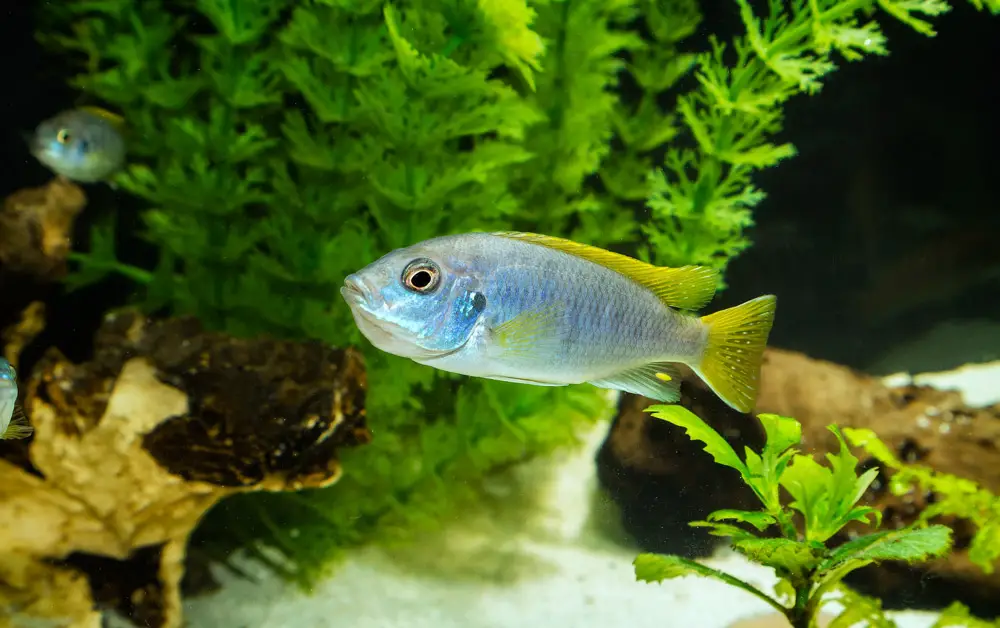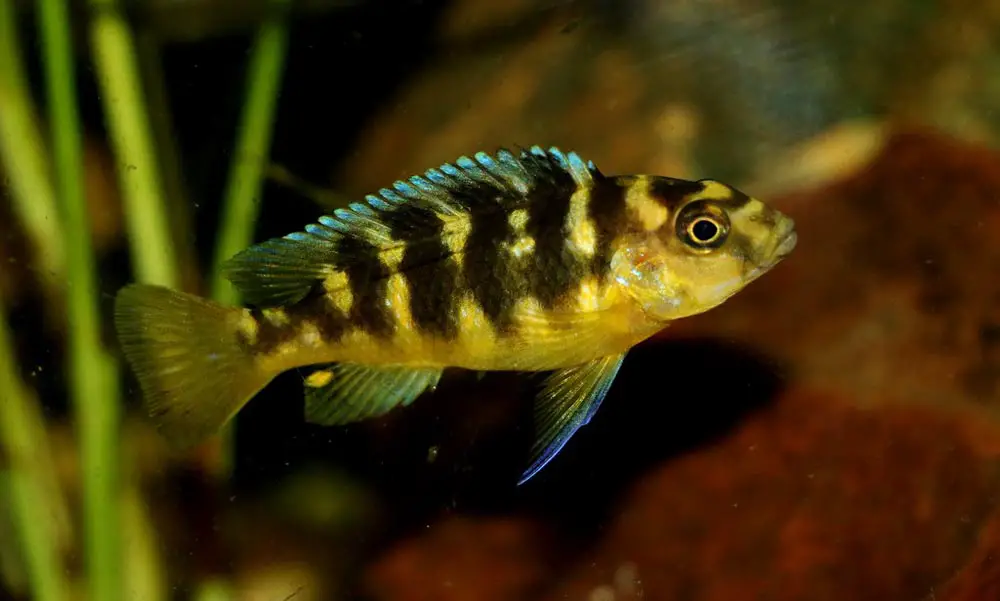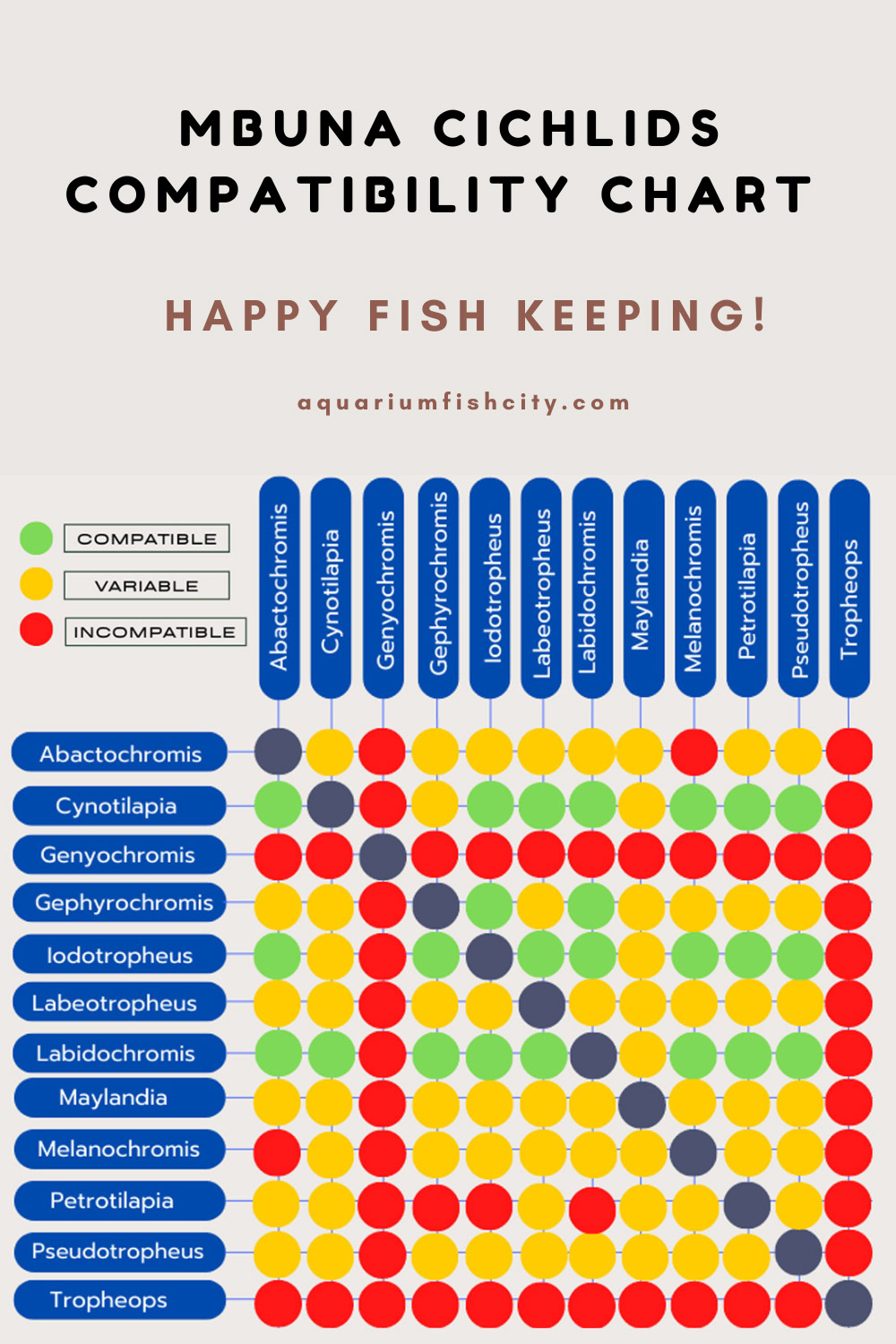So you have finally gravitated toward Mbuna cichlids with their stunning colors but have yet to set up a tank to house these beautiful fish. Then, you are in the right place because this guide will tell you everything there is to know about Mbuna care.
We will cover care tips like their aggression, natural habits, tank mates, size, diet, and different types and their compatibility so you can manage their aggression and keep the peace.
Enjoy!
Mbuna in Nature
Mbuna is one of the large groups of Cichlids that are endemic to Lake Malawi in eastern Africa. The term mbuna means “rockfish” or “rock-dwelling” in the local Tonga language and refers to their habitat.
Unlike other open water swimmers that live in sandy shores, such as Utaka cichlids and many Haps, Mbuna inhabits the rocky shores and coastal zones full of crevices and cracks.
Because of the isolated habitats, Mbuna has evolved into over 295 [1] described species that belong to 13 genera, of which more than 200 remain undescribed, making it one of the most species-rich freshwater fish in the world. Species classified into any of the genera listed below are considered Mbuna.
- Abactochromis
- Cyathochromis
- Cynotilapia
- Genyochromis
- Gephyrochromis
- Iodotropheus
- Labeotropheus
- Labidochromis
- Maylandia
- Melanochromis
- Petrotilapia
- Pseudotropheus
- Tropheops
Mbuna Cichlid Types
Though hundreds of Mbuna species are recognized in the wild, far fewer are stocked and sold as pets. From my many years of experience in the Mbuna world, here are some of the common species:
The 5 Best Beginner-Friendly Mbuna Cichlids

If you’re someone who is planning on your first “peaceful” mbuna aquarium, I highly recommend you start with the following species that are more beginner-friendly.
- Acei Cichlid (Pseudotropheus sp. “acei”)
- Pearl of Likoma (Pseudotropheus joanjohnsonae)
- Electric yellow cichlid (Labidochromis caeruleus)
- Red Top Hongi (Labidochromis sp.)
- Rusty Cichlid (Iodotropheus sprengerae)
Author notes: I have no study to support my claim. It is strictly based on my anecdotal Mbuna experience only. Like any other Cichlids, Mbunas have their own distinct personality. Even a peaceful Yellow Lab can be nasty. You might have a different experience.
Most Aggressive Mbuna Cichlids

Many mbuna cichlids are extremely aggressive and territorial, especially when kept in too small of an aquarium. Some of them can be quite feisty and are often considered a “frequent killer” when they reach maturity.
As a cichlid enthusiast, here are some of the more aggressive Mbuna I have come across over the years:
- Auratus Cichlid (Melanochromis Auratus)
- Purple Mbuna (Melanochromis vermivorus)
- Red Zebra Cichlid (Maylandia estherae)
- Cobalt zebra (Maylandia callainos)
- William’s mbuna (Maylandia greshakei)
- Zebra Mbuna Cichlid (Maylandia Zebra)
- Kenyi Cichlid (Maylandia lombardoi)
- Cynotilapia Afra (Dogtooth Cichlid)
- Blue Mbuna (Labeotropheus fuelleborni)
- Scrapermouth Mbuna (Labeotropheus trewavasae)
- Bumblebee Cichlid (Pseudotropheus crabro)
- Powder Blue Cichlid (Pseudotropheus socolofi)
You might be interested to know: Top 10 Most Popular Mbuna Cichlids with Pictures
Mbuna Size
As we mentioned earlier, there are almost 300 Mbuna species, which means that Mbunas can vary greatly in size. The average Mbuna size will usually reach a length of between 4 to 5 inches long when in captivity.
In the wild, the smaller mbuna will grow to a maximum of about 3 ~ 4 inches (7.6 ~ 10 cm), while the largest species can get up to 8 inches (20 cm).
Below is a Mbuna size and aggression chart for different Mbuna genera:
Aggression: 1 being the relatively peaceful, 5 be the extremely aggressive
| Genus | Size | Diet | Aggression |
|---|---|---|---|
| Abactochromis | 4.7″ (12 cm) | Herbivorous | 4 |
| Cyathochromis | 5.9″ (15 cm) | Herbivorous | 3 |
| Cynotilapia | 5.9″ (10 cm) | Omnivorous | 4 |
| Genyochromis | 5.0″ (12.6 cm) | Piscivore | 5 |
| Gephyrochromis | 5.0″ (12.8 cm) | Herbivorous | 2 |
| Iodotropheus | 4.3″ (10.8 cm) | Omnivorous | 1 |
| Labeotropheus | L. fuelleborni: 12″ (30 cm) Others: 4.5″ (11 cm) | Herbivorous | 4 |
| Labidochromis | 2.5″ – 5.9″ (6.3 – 14.9 cm) | Omnivorous | 2 |
| Maylandia | 3.0″ – 5.9″ (7.6 – 14.9 cm) | Herbivorous | 4 |
| Melanochromis | M. robustus: 7.9″ (20 cm) Others: 2.6″ – 4.9″ (6.6 – 12.4 cm) | Herbivorous | 4 |
| Petrotilapia | 4.3″ – 6.7″ (11 – 17 cm) | Herbivorous | 4 |
| Pseudotropheus | 2.6″ – 6.3″ (6.7 – 16 cm) | Herbivorous | 1 – 4 |
| Tropheops | 2.5″ – 5.5″ (6.4 – 14 cm) | Herbivorous | 4 |
Source: FishbaseMbuna Lifespan
The average lifespan of Mbuna cichlids is between 7 and 10 years with proper care. Like any other pet fish, Mbuna’s lifespan can be greatly influenced by water quality, diet, tank mates, and stress levels.
Mbuna Cichlid Care
When it comes to taking care of Mbuna cichlids, how you can manage their aggression is key. Though we have few “peaceful” candidates, Mbuna is still Mbuna – there are no guarantees that your Mbuna will get along with other Mbuna (or any other fish for that matter!) in your aquarium.
Aggression & Social Hierarchy
Mbuna cichlids are aggressive and territorial and are not considered community fish in any way. They display the most aggression towards their own kind and other species with the same or similar coloration and pattern. Aggressive behavior in Mbuna cichlids primarily consists of chases and bites.
Scientists believe Mbuna is more aggressive than haps and peacocks due to its distinct habitat (social) structure and reproduction [2]. Like many other types of African cichlids, a male Mbuna must defend a spherical territory to ensure the success of reproduction in a high amount of habitat structure. Therefore, any similar-looking fish will be perceived as a threat to a polygamous male’s harem.
Interestingly, these two factors also apply to these aggressive CA& SA cichlids, especially in females. [3]
There are many ways to reduce this aggression and cut down the mortality rates among aquarists:
- First and foremost, ensure your selected species have the same aggression level.
- Start with juveniles for mixed Malawi aquariums.
- The sex of your fish is important. I would recommend the All-Male Mbuna tank for lightly or moderately stocked plans.
- Heavy stocking with strong filtration and large water changes.
- Avoid housing closely related species of the same genus or with a similar appearance.
- If you plan to introduce more fish, add more than 3 fish at one time.
- Dim the lights a bit more (or turn them off) except during feeding times.
- Since warmer water increases aggression in tropical fish [4], try to keep their water temperature at 72 to 75 ° F (22 to 23.8° C)
- Periodic small feedings can also help reduce aggression.
Tank Size
As you might know, Lake Malawi is the third largest and second deepest [5] lake in Africa. When setting up a good aquarium for Mbuna, you should try to replicate the deep and wide lake environment.
While salesman and breeders recommend a 30-gallon tank, I believe this is only adequate for stocking Mbuna juveniles. Once Mbuna grow to their full size, they will require much more room, and a 30 gallons tank will be completely inadequate. A 55-gallon aquarium is actually the minimum you should go for a long term Mbuna cichlid keeper.
The stocking number of Mbuna depends on your fish size and stocking density [6]. Hopefully, the following chart can give you some ideas:
For a 55-gallon tank:
| Fish Size | Light Stocking | Medium Stocking | Heavy Stocking |
|---|---|---|---|
| 4″ | 5 | 16 | 49 |
| 5″ | 2 | 9 | 25 |
| 6″+ | 1 | 4 | 15 |
For a 125-gallon tank:
| Fish Size | Light Stocking | Medium Stocking | Heavy Stocking |
|---|---|---|---|
| 4″ | 10 | 32 | 98 |
| 5″ | 5 | 17 | 50 |
| 6″+ | 3 | 9 | 29 |
Water Chemistry
Water chemical characteristics involve parameters such as pH, temperature, alkalinity, and dissolved oxygen, which are vital for Mbuna’s care.
Lake Malawi is a rift lake that is very alkaline yet has relatively soft to moderately hard water, which is caused by the high evaporation rate and dissolved carbon dioxide (DIC) in water.
Since there are no tides or currents, most Mbuna lives in the depth of 130–330 ft (40–100 m), where the dissolved oxygen and temperature is more stable.
Therefore, you should attempt replicating these water parameters in the home aquarium.
- Water temperature: 72 to 75 ° F (22 to 23.8° C)
- pH levels: 7.8 to 8.6
- Water hardness: 4.0-7.5 dH
- Ammonia: 0 ppm
- Nitrite: 0 ppm
- Nitrate: <30 ppm
To attain and maintain a high pH in your tank, the most common method is to use a substrate of crushed coral sand that naturally raises and maintains a stable high pH level. Well, if you choose other types of substrates, you can use it in the filter(s), it will dissolve faster. Similar materials like crushed seashells or aragonite can also be used.
[amazon box=”B000255PJY”]Aquarists sometimes recommend Seachem’s Cichlid Lake salt as a buffering to increase the carbonate hardness in Malawi aquariums.

However, just as the label states, it’s largely chlorides. Lake Malawi has a very low level of chloride in water (CL< 4.3 ppm) [7]. So I would not recommend using this product.
I’m not saying this product is bad, but it’s not what you should be using to duplicate their natural habitat. Additionally, tap water can provide all the necessary trace element nutrition your fish needs. It also comes with a high price tag.
If you strive for perfection in recreating the water chemistry of Lake Malawi. Simply add 2- 3 level teaspoons baking soda (sodium bicarbonate) and 1/4 teaspoon Epsom salts (magnesium sulfate) to 25 gallons of soft neutral water. These are the best products in terms of price and availability.
Decor
Given the fact that these fish come from the rocky areas and reefs of Lake Malawi, Mbuna cichlids care in the aquarium would ideally consist of a sandy bottom with plenty of rocks.
A good option is limestones. Not only do they provide your fish with hiding places, natural decoration, and spawning sites, but they also aid in raising and buffering the pH and hardness.
Mbuna are avid diggers, so make sure the rocks are well secured, or they will dig them up and rearrange the entire aquarium.
There are other decorations you can use. My personal favorite is clay pots or pipes. These can be very attractive, as well as offer a place to hide when they feel threatened. Mbuna will also often lay their eggs in these pots or pipes.
Food & Diet
Besides their aggression, Mbuna is well known to be susceptible to getting what has become known as Malawi bloat, which is called African cichlid disease or African bloat.
I know you probably have heard that the main cause of Mbuna bloat is the high protein diets. But in my experience, stress and poor water quality are two major culprits leading to Mbuna bloat and other diseases.
Most Mbuna cichlids are herbivores except for Genyochromis mento, a notorious fin-biter and scale-eater. In the wild, they primarily feed on aufwuchs – a combination of algae, diatoms, biofilm, and tiny organisms like crustaceans and insect larvae.
In the aquarium, you should provide them with a staple diet that consists of high-quality cichlid pellets or flakes, supplemented with vegetable matter and small meaty food, such as insects, Mysis, and brine shrimp.
Mbuna Tank Mates
A common question is, what fish are compatible with my Mbuna cichlids? Well, the answer to this question depends heavily on which species you’re talking about and how you plan to stock your tank.
Generally speaking, Mbuna should be kept with mbuna only. For beginners, start with a specie-only tank with one of the “peaceful” mbuna in the above list. Buy a group of juveniles to give you a better chance of getting at least one male. Raise the fish together and allow them to form their own hierarchy.
Once you learn about the path of Mbuna cichlids care, you can try your hand at a mixed Mbuna tank. If you want to go this route, do your homework and make sure the species you’re interested in are compatible.
Mbuna Cichlids Compatibility Chart
Below is our Mbuna compatibility chart that covers the 13 genera. This chart is a guideline to help you determine which Mbuna are compatible with each other.

Mbuna Cichlids Compatibility Chart For those interested in the Malawi show tank, an All-Male mixed tank is a way to go. This will give you the most vibrant colors without worrying about the burden of groups of babies. Of course, it can be challenging since monomorphic species are difficult to sex.
Breeding Mbuna Cichlids
Mbunas are easy to breed in the aquarium; these colorful and handy fish are maternal mouthbrooders and often reach sexual maturity about a year old and have grown to about 3 inches.
Males tend to grow slightly larger than females and often have more pronounced coloration. A dominant male will have the brightest and most rich colors and will not allow any subdominant males to mate within his territory.
In certain species, subdominant males usually fade in color to look like females to avoid aggression from the dominant male. Quite often, in an all-female tank, a dominant female will show male traits and colors.
Like haps, Mbunas are polygamous and form harems in the wild consisting of 1 male to several females.
When ready to spawn, the males will dig a nest in the sand or among the rocks, to where they will then entice the female to lay her eggs. A female usually lays between 10 to 30 eggs per clutch, depending upon the size of the female.
After the female Mbuna lays her eggs in the nest, the male fertilizes them. The female will then scoop up the eggs in her mouth and carry them around until they hatch, which usually takes between 21 to 31 days, during which they will not eat.
During this period, the female can get very weak and more easily stressed. Sometimes, she may spit out the brood too early or even eat them, so separating the female from the group is recommended.
Author notes: Breeders often strip the fry from the female’s mouth at the two-week stage to raise them in a separate tank to improve the fry’s survival rate.
The fry are free-swimming about 3 to 7 days after hatching and will start to look for food. Mbuna fry are very small, so you will need to provide them with live foods, such as baby brine shrimp or microworm.
Avoid Crossbreeding
Mbuna have proven themselves to be one of the easiest aquarium fish to breed. However, avoiding crossbreeding Mbuna with other cichlid species is important since we don’t need more hybrids. [8]
That’s why you should not keep two or more species in the same genus in your tank —as a thumb rule, crossbreeding usually happens when fish from within the same genus, particularly a male of one species and only the female of another.
Guide Wrap Up
Now, you have Mbuna cichlids care basics to help you get started with these amazing African cichlid species. They are some of the most colorful freshwater fish you’ll find and make an exciting addition to your home aquarium, but they are simply very aggressive.
Learning how to deal with their aggression is critical to your success in keeping Mbunas. Hopefully, this Mbuna cichlids care guide has given you the information you need.
Do you have Mbuna cichlids in your tank? Share your Mbuna experience with us in the comment section below. Also, if you have any suggestions to help us improve the care guide, we would love to hear from you.
Article Sources:
- The mbuna cichlids of Lake Malawi: a model for rapid speciation and adaptive radiation [Link]
- Aggression in closely related Malawi cichlids varies inversely with habitat complexity [Link]
- Habitat structure directly affects aggression in convict cichlids Archocentrus nigrofasciatus [Link]
- Water warming increases aggression in a tropical fish [Link]
- Lake Malawi – Wikipedia [Link]
- Calculating Stocking Ratio [Link]
- What Is the Chemical Composition of Lake Malawi Water? [Link]
- Who Needs Another Hybrid? [Link]

Mbunas do not do well with temps of 72-75°. They are more prone to health issues. This is also the only website that I have come across that says below 76. They should be kept at 76-80°.
Hi Viola,
Thank you for your question.
The average annual water temperature of Lake Malawi is 75° F and scarcely changes, given that it sits right on the equator. Therefore, a few degrees on either side of the average temperature would be the optimum range for cichlids endemic to that area.
It’s true that any water temps too far off on either side can cause stress in fish, which weakens their immune system.
However, as I mentioned in the post, the cooler the water the less the aggression. This is why I suggested a temperature range of 72-75° F, since that would be slightly cooler than the average (but still within safe limits).
Of course, it’s only my observation and advice, but it should be taken into account when you are keeping the mbunas and setting up your tank.
Hope this helps!
Ivan